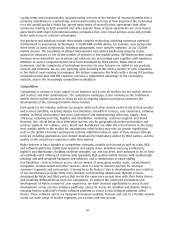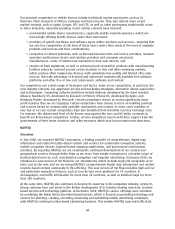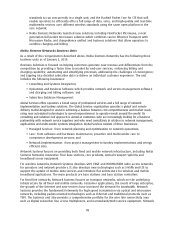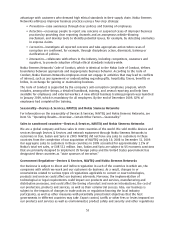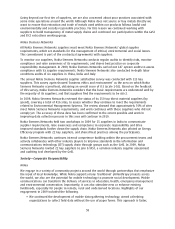Nokia 2009 Annual Report Download - page 54
Download and view the complete annual report
Please find page 54 of the 2009 Nokia annual report below. You can navigate through the pages in the report by either clicking on the pages listed below, or by using the keyword search tool below to find specific information within the annual report.In services, the fastest growing part of the industry, which includes managed services (outsourcing),
consulting, systems integration and hosting, vendors are judged on their ability to identify and solve
customer problems rather than their ability to supply equipment at a competitive price. The
competition is from both traditional vendors such as Ericsson, as well as nontraditional
telecommunications players such as Accenture, HP and IBM. HP is active in the service delivery
platform market and IBM is active, for example, in the billing and data center businesses. In addition
to these companies, there are many other competitors, such as Fujitsu, Juniper, Samsung and Tellabs,
which have a narrower scope in terms of served regions and business areas.
Conditions in the market for mobile and fixed networks infrastructure and related services remained
challenging and intensely competitive in 2009, as the difficult conditions that emerged in 2007
continued and were exacerbated by the financial and economic crisis that emerged towards the end
of 2008. The market continued to be characterized by equipment price erosion, a maturing of
industry technology and intense price competition, and we believe the market is estimated to have
declined in euro terms by approximately 5% in 2009 compared to 2008. Certain exchange rate
fluctuations, particularly between the euro and the Swedish crown and between the euro and the
Chinese yuan, have benefited some of our main competitors in 2009. Nokia Siemens Networks
competes with companies that have larger scale and higher margins affording them more flexibility
on pricing, while some of the competitors may receive certain governmental support allowing them
to offer products and services at very low prices. Further, in many regions restricted access to capital
caused operators to reduce capital expenditure and produced a stronger demand for vendor
financing. Some of Nokia Siemens Networks’ competitors may have stronger customer financing
possibilities due to internal policies or government support. Nokia Siemens Networks has decreased
the amount of financing directly provided to its customers in 2009, but it has arranged and
facilitated, and plans to continue to arrange and facilitate, financing to a number of customers,
typically supported by Export Credit or Guarantee Agencies (“ECA’s”).
In radio networks businesses, the 2G (GSM) segment is facing intense price competition in emerging
countries, where operators need to make large investments in networks but generally receive low
revenues per customer. As a result, European vendors have all reported heavy downturns in these
areas, where Chinese vendors are believed to be gaining share. In mature markets, there has been a
slowdown in operator investments. Within the 3G segment, leading vendors are competing based on
factors including technology innovation, such as lower energy consumption equipment, and less
complex network architectures.
The fixed line market continues to be characterized by intense price pressure, both in terms of
equipment price erosion due to heavy competition, especially from Asian vendors, and from declining
tariffs, which are expected to continue to fall. Decreasing fixed line revenues combined with rising
voice and data network traffic are expected to force network operators to invest in new business
opportunities and continue their network evolution to converged IP/Ethernet and wavelength
division multiplexingbased transport architectures. The global trend of subscribers moving to mobile
communications from fixed communications is expected to continue, especially with the growth in
the number of mobile subscribers in markets where it is not economically feasible to build a fixed
network.
Compliance program
Nokia Siemens Networks has adopted high ethics and integrity standards. The company is committed
to actively fight against improper business practices, including corruption, and Nokia Siemens
Networks believes that as a multinational company it can play an important role in this area. Nokia
Siemens Networks also believes that its efforts in this area can provide it with a competitive
52



